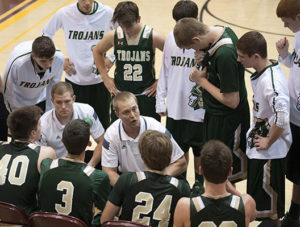Halftime adjustments to spark your team
Rarely do you find a basketball game that plays exactly the same from the first half to the second. Teams go into the locker room at halftime, and make critical adjustments.
But when one team plays better, the other one plays worse. So what happens at halftime?
 If you know how to manage a halftime from buzzer to buzzer, you’re in a much better position to spark a second-half run. Or, if you’re leading, it allows you to hold off the opponent. Don’t let these precious minutes slip away — they might hold the key to victory.
If you know how to manage a halftime from buzzer to buzzer, you’re in a much better position to spark a second-half run. Or, if you’re leading, it allows you to hold off the opponent. Don’t let these precious minutes slip away — they might hold the key to victory.
Affect opponent’s halftime
A great way to cut into an opponent’s halftime is to give them something to think about just before the break.
Try changing into a defense that your opponent has no idea you run. As they jog into the locker room, the first thing they’re going to do is to address the “new” defense they just saw. Now, they’re wasting valuable minutes covering something you will not run again during the game.
Timing is everything
Whether you decide to toss out a junk defense just before halftime or not, as soon as that buzzer sounds, you need to go to work. Remember, you have a limited time to think, speak with your team, and provide a second-half warm-up. Using a systematic approach to halftime gives you the best chance for victory.
Halftimes range in number of minutes, but for these purposes consider a halftime with 15 minutes. Utilize every minute by scripting your halftime down to the minute. Here is a basic script:
- Minutes 0-2: Meet with your staff on the bench and take notes, then make your way to the locker room.
- Minutes 2-3: Make general comments about the first half.
- Minutes 3-8: Review the first half from an offensive and defensive standpoint while noting second-half adjustments.
- Minutes 8-10: Re-emphasize the second-half changes in a succinct understandable language.
- Minutes 10-14: Head back to the court and start second-half warm-up.
- Minutes 14-15: Reiterate adjustments one final time before the second half begins.
When you time your halftime down to the minute, you need to have someone assigned to watch the clock. An assistant coach is a logical choice, but consider setting your own watch before entering the locker room. If there is a timing problem, it’s better for it to be your responsibility.
During those the first minutes when you’re on the court, have the coaching staff note offensive and defensive things they saw during the first half. As the head coach, you also make offensive and defensive notes. After a minute, discuss notes with the staff as you walk to the locker room.
Upon entering the locker room make general comments to the team, which typically include exhortations and sometimes admonishments. For example, “That was a great half, because we really did X, Y and Z.” Or, “Because we didn’t do X and Y, we didn’t have a good first half. I am pleased with how we were able to do Z.” After those comments, players have a general understanding of your assessment of the first half of play.
After preliminary comments, dig into the heart of halftime. During these critical five minutes, go over both offensive and defensive areas. To keep the team on task, refer to the game plan as often as possible. Also, during these five minutes, you are developing a second-half game plan with the staff and the team.
You also must use this time to focus on what your team does well. Even if you are getting crushed but you know your team has a high-powered attack, concentrate on better offensive execution with a few notes on defense. This suggests that if the offensive execution is better, then that can fuel the defense
Getting direct player input during halftime is tricky. It certainly isn’t something you want to do for every game. But the players are the ones who have to execute the plan. Let them aid in the technical plan, while you give them the schematic plan. For example, you make a schematic choice to play zone defense in the second half. In that adjustment, work with your post player on how he or she wants to defend the post — top side, play behind, dead front. Players have a level of accountability when they are part of the decision-making process.
The final two minutes in the locker room are used to synthesize the previous five minutes down to two or three basic concepts. An example might be, “Remember, on offense we need to continue the dribble-drive and do a better job of crashing the glass. On defense let’s make sure we play better help-side defense on No. 25 and be ready to jump into our press after free throws.”
Next, bring the team together while the coaches leave the locker room. This provides the players a moment to speak with each other before they head back for the second-half warm-up. During the walk to the court, check with your coaching staff to make sure you didn’t miss any points of emphasis.
Just before the players take the court for the second half, try to reiterate the final synthesized points of the halftime talk in an effort to execute the necessary changes to win the second half.









